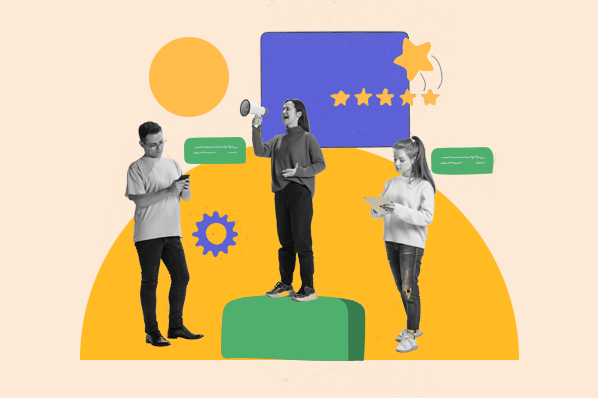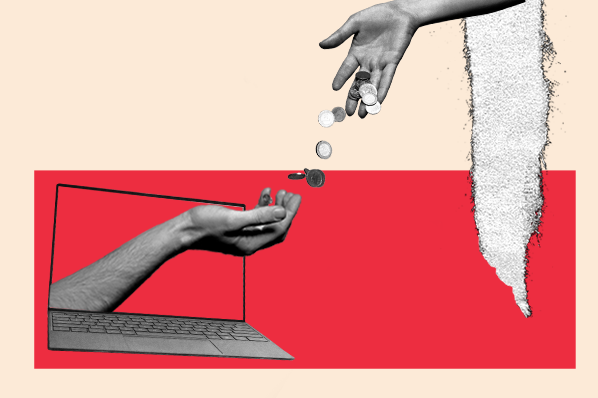It's easier to sell to an existing customer than it is to acquire a new one.

The last thing you want is for customers to churn before you recoup the investment required to earn their business in the first place.
One of the best ways to mitigate this is by measuring customer lifetime value (CLTV). Doing so will help your business acquire and retain highly valuable customers, which results in more revenue over time.
Continue reading or jump ahead:
- What is customer lifetime value (CLV)?
- Why is customer lifetime value important?
- Customer Lifetime Value Models
- Customer Lifetime Value Formula
- How to Calculate Customer LTV
- Customer Lifetime Value Metrics
- Customer Lifetime Value Example
- Tips to Increase Customer LTV
What is customer lifetime value (CLV)?
Customer lifetime value (CLV, or CLTV) is a metric that indicates the total revenue a business can reasonably expect from a single customer account throughout the business relationship.
The metric considers a customer's revenue value and compares that number to the company's predicted customer lifespan.
Customer LTV is something that customer support and success teams can directly influence during the customer's journey.
The longer a customer continues to purchase from a company, the greater their lifetime value becomes.
Free Customer Lifetime Value Calculator
Tell us a little about yourself to access the template.
Why is customer lifetime value important?
Customer lifetime value is important because it gives you the power to leverage the value of each customer during the buyer's journey. You can use CLV to increase customer loyalty, reduce churn, and make strategic business decisions to meet customer needs.
For example, you can use customer lifetime value to identify customer segments that are most valuable to the company and target accordingly.
Here are some other reasons why understanding your CLV is essential.
1. Increasing CLV can increase revenue over time.
The longer the lifecycle or the more value a customer brings during that lifecycle, the more revenue a business earns.
Therefore, tracking and improving CLV results in more revenue.
CLV helps you identify the specific customers that contribute the most revenue to your business. You can use this information to tailor your offerings to your highest spenders and keep them coming back for more.
2. It can help you identify issues so you can boost customer loyalty and retention.
If you review CLV as a priority in your business, you can identify any worrying trends and come up with action items to address them.
For example, if you find the CLV to be consistently low, you can work to optimize your customer support strategy or loyalty program to better meet the needs of your customers.
3. It helps you target your ideal customers.
When you know the lifetime value of a customer, you also know how much money they spend with your business over some time — whether it's $50, $500, or $5000.
Armed with that knowledge, you can develop a customer acquisition strategy that targets customers who will spend the most at your business.
4. Increasing CLV can help reduce customer acquisition costs.
Acquiring new customers can be costly.
As noted by a recent article from The European Business Review, acquisition is typically five times more expensive than retention.
This shows that it's essential that your business identifies and nurtures the most valuable customers that interact with your company.
By doing so, you'll have higher profit margins, increased customer lifetime values, and reduced customer acquisition costs.
Now that we understand the importance of customer lifetime value, let's talk about the two main customer lifetime value models.
Customer Lifetime Value Models
There are two models that companies will use to measure customer lifetime value.

Choosing between the two can result in different outcomes.
This depends on whether a business is looking at pre-existing data, or trying to determine the future behavior of customers based on current circumstances.
Predictive Customer Lifetime Value
The predictive CLV model forecasts the buying behavior of existing and new customers using regression or machine learning.
Using the predictive model for customer lifetime value helps you better identify your most valuable customers, the product or service that brings in the most sales, and how you can improve customer retention.
Historical Customer Lifetime Value
The historical model uses past data to predict the value of a customer without considering whether the existing customer will continue with the company or not.
With the historical model, the average order value is used to determine the value of your customers. You'll find this model to be especially useful if most of your customers only interact with your business over a certain period.
However, because most customer journeys are not identical, this model has certain drawbacks.
Active customers (deemed valuable by the historical model) might become inactive and skew your data.
In contrast, inactive customers might begin to buy from you again, and you might overlook them because they've been labeled "inactive."
Read on to learn about the different metrics needed to calculate customer lifetime value and why they're important.
Customer Lifetime Value Formula
The customer lifetime value formula is customer value multiplied by the average customer lifespan. The result gives you the revenue you can reasonably expect an average customer to generate for your company throughout their relationship with you.

How to Calculate Customer LTV
Customer Lifetime Value = (Customer Value * Average Customer Lifespan). To find CLTV, you need to calculate the average purchase value and then multiply that number by the average number of purchases to determine customer value. Then, once you calculate the average customer lifespan, you can multiply that by customer value to determine customer lifetime value.
We'll look at both components of this formula (and how to calculate them) below.
Customer Lifetime Value = (Customer Value* x Average Customer Lifespan)
*Customer Value = (Average Purchase Value x Average Number of Purchases)
Customer Lifetime Value Metrics
Knowing that there are many different ways to approach lifetime value calculation is useful to businesses in more ways than one.
It helps businesses gauge financial viability and can improve customer retention with a data-driven understanding of what existing customers find valuable from your business.
As we examine the most common CLV formulas, analyze the variables that contribute to each to better serve your business needs.
Average Purchase Value
Calculate this number by dividing your company's total revenue in a period (usually one year) by the number of purchases throughout that same period.

Average Purchase Frequency Rate
Calculate this number by dividing the number of purchases by the number of unique customers who made purchases during that period.

Customer Value
Calculate this number by multiplying the average purchase value by the average purchase frequency rate.

Average Customer Lifespan
Calculate this number by averaging the number of years a customer continues purchasing from your company.

Customer Lifetime Value Example
Using data from a Kissmetrics report, we can take Starbucks as an example for determining CLTV.
Its report measures the weekly purchasing habits of five customers, then averages their total values together.
Follow Along with HubSpot's CLV Calculator Template
By following the steps listed above, we can use this information to calculate the average lifetime value of a Starbucks customer.
1. Calculate the average purchase value.
First, we need to measure average purchase value.
According to Kissmetrics, the average Starbucks customer spends about $5.90 each visit. We can calculate this by averaging the money spent by a customer in each visit during the week.
For example, if I went to Starbucks three times and spent nine dollars total, my average purchase value would be three dollars.
Once we calculate the average purchase value for one customer, we can repeat the process for the other five.
After that, add each average together, divide that value by the number of customers surveyed (five) to get the average purchase value.
2. Calculate the average purchase frequency rate.
The next step to calculating CLTV is to measure the average purchase frequency rate.
In the case of Starbucks, we need to know how many visits the average customer makes to one of its locations within a week.
The average observed across the five customers in the report was found to be 4.2 visits. This makes our average purchase frequency rate 4.2.
3. Calculate the average customer's value.
Now that we know what the average customer spends and how many times they visit in a week, we can determine their customer value.
To do this, we have to look at all five customers individually and then multiply their average purchase value by their average purchase frequency rate. This lets us know how much revenue the customer is worth to Starbucks within a week.
Once we repeat this calculation for all five customers, we average their values to get the average customer's value of $24.30.
4. Calculate the average customer's lifetime span.
While it's not explicitly stated how Kissmetrics measured Starbucks' average customer lifetime span, it does list this value as 20 years.
If we were to calculate Starbucks' average customer lifespan, we would have to look at the number of years each customer frequented Starbucks. Then we could average the values together to get 20 years.
If you don't have 20 years to wait and verify that, one way to estimate customer lifespan is to divide 1 by your churn rate percentage.
5. Calculate your customer's lifetime value.
Once we have determined the average customer value and the average customer lifespan, we can use this data to calculate CLTV.
In this case, we first need to multiply the average customer value by 52. Since we measured customers on their weekly habits, we need to multiply their customer value by 52 to reflect an annual average.
After that, multiply this number by the customer lifespan value (20) to get CLTV.
For Starbucks customers, that value turns out to be $25,272 (52 x 24.30 x 20= 25,272).
Tips to Increase Customer LTV
Now that you know your customer lifetime value, how do you increase it?
Here are some strategies that can help.
1. Optimize your onboarding process.
Customer onboarding is the process of bringing your customers up to speed with your brand — what you do, why it matters, and why they should stick around.
Onboarding happens in the first few days after customers make their first purchase.
When they head back to your website to look at other items or connect with you via email, they're learning how your company works and what you can offer.
The result? You need to stand out while making this straightforward.
Use the data customers have provided to offer curated item selections or great deals, and then follow up with email contacts to make sure what they've already bought lives up to expectations.
Why This Works
Optimized onboarding processes work because they establish a framework for long-term customer relationships that help increase CLV over time.
2. Increase your average order value.
One of the smartest ways to improve your CLV is to increase your average order value.
When a customer is about to check out, you can offer relevant complementary products to those they're about to buy.
Brands like Amazon and McDonald's are examples of companies that use the upsell and cross-sell method extremely well.
Amazon will offer you related products and bundle them into a group price as depicted below.

McDonald's, meanwhile, offers small add-ons — such as those delicious apple pies — that help boost overall CLV.
If you're a subscription-based company, you can increase your average order and customer lifetime value by encouraging your customers to switch to an annual billing cycle.
Why This Works
This works because even a small increase in order value over time leads to increased CLV and overall revenue.
Consider the example of the McDonald's apple pie. While adding a $1(ish) item to each transaction isn't much on its own, over time these smaller amounts add up to substantive revenue and help increase total CLV.
3. Build long-lasting relationships.
Long-term customer relationships are based on trust.
If buyers believe that your company offers them the best prices on the products and services they want, they'll come back. But this is just the beginning.
With social media now a critical part of any branding and marketing efforts, customers want more than just a business-based relationship.
They want to cultivate a personal connection that makes them feel like more than simply a road to better business ROI.
As a result, it's critical to engage with customers on your social media accounts with more than just canned advertising posts.
For example, you could do some social sleuthing to discover more about your customers and then send them a (small) free gift that aligns with their interests.
Why This Works
This works because you need to stand out from the crowd. Quick and easy eCommerce is now par for the course — if you can forge an actual connection with customers you'll keep them coming back and increase your total CLV.
4. Embrace good advice.
Sometimes it's better to listen than talk.
Customers often have good advice on how you could improve business practices to better serve their needs — and you can increase CLV by taking it.
For example, you could create a poll on new product or service ideas and see what your customer base thinks.
Make sure you don't lock them into a specific set of choices. Instead, give them room to add their own ideas that could help make things better.
While not every customer will participate, those that do will often have good advice and can end up being some of your most loyal customers.
Quick tip: Give credit where credit is due. If a customer comes up with a good idea, credit them for the help and consider sending them something as a token of appreciation.
Why This Works
This works because it shows you're willing to listen. Too many brands take the stance that they know what their customers want better than customers themselves, which in turn can lower total CLV.
By taking the time to listen and respond — even if customer advice isn't exactly what you want to hear — you can facilitate long-term loyalty and boost CLV.
5. Empower easy connections.
Customers won't wait around for your brand to connect with them or answer their questions. Recent survey data found that 88% of customers want a response to emails in one hour or less.
While this isn't always possible, businesses can put practices in place to shorten response times and empower easy connections.
Active social media is one example. By equipping a customer success team with the tools and technology to monitor and respond to customer comments or concerns via social media, brands can jumpstart the connection process.
Why This Works
CLV is now driven by relationships and relationships require an ongoing connection.
While one-hour email response times may be out of reach, the easier you make it for customers to connect with your brand the more connected they'll feel overall.
And the more likely they'll come back to spend more money.
6. Improve your customer service.
90% of Americans say that customer service is one factor they consider when choosing companies to do business with.
So if you want to improve your customer lifetime value, you should pay attention to your customer service and look for ways to make it excellent.
You can improve your customer service by offering existing customers personalized services, omni-channel customer support, and a proper return or refund policy.
Why This Works
It's simple: The better your customer service the more customers feel valued by your brand for more than their purchases.
If you stand behind your products with substantive return and refund policies, it communicates to customers that your priority is quality and satisfaction, not overall sales volume.
The result? Increased CLV.
The Benefit of Customer Lifetime Value
Customer lifetime value is an incredibly useful metric. It tells you which customers spend the most at your business and which ones will remain loyal to you for the longest amount of time.
Use the formulas and model provided above and start calculating CLTV for your business today.
Editor's note: This post was originally published in May 2021 and has been updated for comprehensiveness.
![→ Download Now: Customer Service Metrics Calculator [Free Tool]](https://no-cache.hubspot.com/cta/default/53/e24dc302-9dc2-466f-a5ca-ab4e08633c0f.png)


![How to Calculate Churn Rate in 5 Easy Steps [Definition + Formula]](https://blog.hubspot.com/hubfs/calculate-churn-rate.jpeg)








